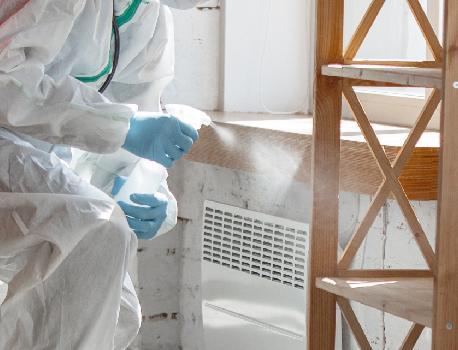A Guide to Removing Asbestos in Your House

Asbestos in houses poses a significant concern for homeowners due to its potential health risks. It is a prevalent issue, especially in properties constructed before the 1980s, when asbestos was commonly used in building materials. Asbestos demands careful consideration and, in many cases, professional intervention for removal.
The process involves adherence to local regulations and safety standards to ensure asbestos's safe and legal removal.
Safely disposing of asbestos-containing materials is a careful process, demanding compliance with strict disposal protocols to prevent environmental contamination.
This exploration will walk you through the essential steps and considerations in removing asbestos from your house.
Key Takeaways
- Asbestos in houses demands attention due to potential health risks, necessitating a careful approach to removing asbestos.
- Removing asbestos from your house requires professionals who can accurately assess, contain, and mitigate asbestos removal.
- Post-removal, continuous air quality monitoring ensures a safe environment for reoccupation, completing the process of removing asbestos from the house.
Understanding and Safely Addressing Asbestos in Houses: Steps to Removing Asbestos
Asbestos in houses is a significant concern for homeowners, given the potential health risks of this once-widely-used construction material. Furthermore, asbestos, known for its fire-resistant and insulating properties, was extensively utilized in building materials until its health hazards became widely recognized.
1. The Prevalence of Asbestos in Houses
Asbestos was a popular choice in construction due to its versatility and affordability, leading to its widespread use in homes built before EPA regulatory restrictions came into effect in 1989 under the Toxic Substances Control ACT (TSCA). Insulation, flooring, ceiling tiles, and roofing materials are common areas where asbestos may exist. The first step is the prevalence of asbestos in your house.
2. Health Risks Associated with Asbestos
Inhaling airborne fibers of asbestos in the house poses severe health risks. Additionally, prolonged exposure can lead to respiratory issues, lung diseases, and cancer.
Identifying the health risks emphasizes the need to deal with and eliminate asbestos from your home.
3. Professional Assessment and Expertise
Identifying asbestos-containing materials (ACMs) is a specialized task that requires professional assessment. Certified asbestos inspectors have the expertise to accurately identify ACMs and assess the extent of their presence in your home.
4. Regulatory Compliance and Permits
Asbestos removal is regulated, and compliance with local regulations is essential. Before initiating the removal process, homeowners should obtain the necessary permits and notify relevant authorities. This ensures the removal is conducted under established safety standards and legal requirements.
5. Scope of Removal and Containment Measures
Determining the scope of asbestos removal involves identifying the affected areas and materials. Once identified, containment measures are implemented to prevent the release of asbestos fibers during removal. These measures include sealing off the work area, using protective barriers, and employing specialized equipment to minimize the risk of fiber dispersion.
6. Professional Removal Techniques
When dealing with asbestos in your house, certified asbestos removal professionals employ various techniques based on the specific circumstances of each case. Encapsulation and complete removal are common methods for managing asbestos. Encapsulation involves sealing asbestos with a protective coating while complete removal safely extracts and disposes of asbestos-containing materials. The choice depends on factors such as the extent of asbestos presence and the condition of the materials.
7. Safe Disposal Protocols
The disposal of asbestos-containing materials is a critical aspect of the removal process. Strict protocols govern the safe disposal of asbestos to prevent environmental contamination. Certified professionals ensure disposal is carried out under regulatory guidelines, safeguarding the environment and public health.
8. Air Quality Monitoring
Air quality monitoring is essential to the asbestos removal process. This ensures that the air within and around the work area remains free from asbestos fibers during removal and that the environment is safe for reoccupation after the process.
9. Post-Removal Considerations
After successfully removing asbestos in houses, homeowners should consider post-removal measures. This includes necessary repairs or renovations to restore the affected areas to their original condition. Additionally, vigilant monitoring for any signs of asbestos reappearance is advisable to ensure the long-term safety of the home.
10. The Role of Homeowners in the Process
While professionals handle the technical aspects of asbestos removal, homeowners play an important role in facilitating a smooth process. This includes providing accurate information about the home's construction history, cooperating with the assessment and removal teams, and following professional guidelines.
Conclusion
Removing asbestos from your house requires careful planning, professional expertise, and strict adherence to safety protocols. The health risks associated with asbestos make it imperative that homeowners prioritize its safe removal. By understanding the prevalence of asbestos in houses, recognizing health risks, engaging certified professionals, and following proper procedures, homeowners can ensure the safe and effective removal of asbestos from their homes. This protects the well-being of occupants and contributes to creating a safe and healthy living environment for years to come.
FAQs
1. Can I Identify Asbestos in My House Without Professional Help?
Identifying asbestos in your house requires specialized knowledge and testing. While some visual cues may indicate its presence, a certified asbestos professional should thoroughly inspect for accurate identification.
2. Can I Test for Asbestos Before Purchasing a Home?
Yes, pre-purchase asbestos testing is advisable, especially for older homes. Hire certified asbestos inspectors to assess the property and provide information about any asbestos-containing materials that may require attention.
3. Is Asbestos Removal Tax Deductible?
Asbestos removal expenses are generally not tax-deductible for residential properties. Consult with a tax professional to understand specific regulations and potential exceptions.


